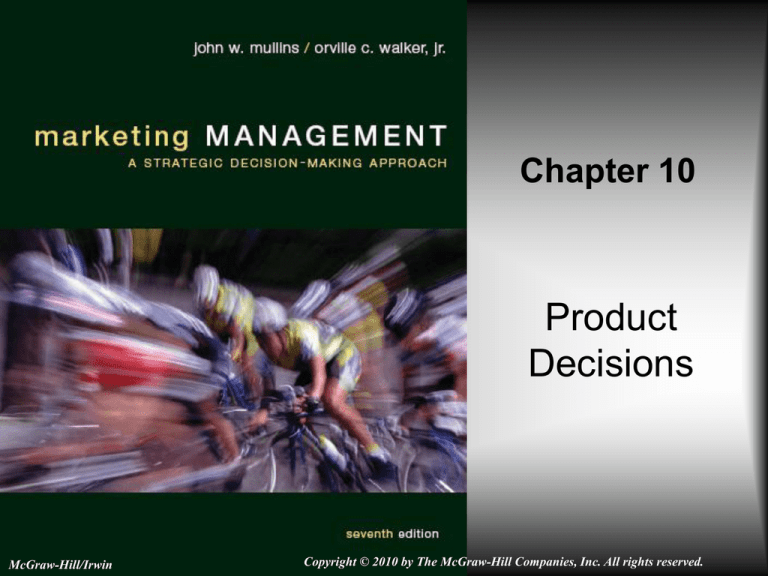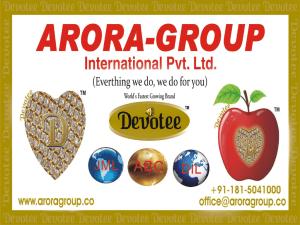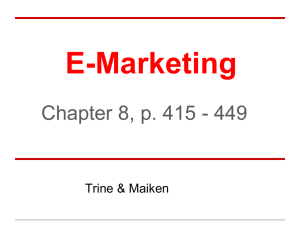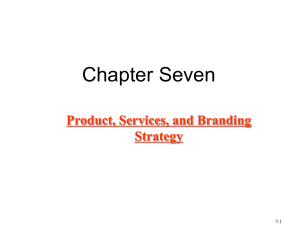
Chapter 10
Product
Decisions
McGraw-Hill/Irwin
Copyright © 2010 by The McGraw-Hill Companies, Inc. All rights reserved.
Product Design Decisions for
Competitive Advantage
•
•
A product can be defined as anything
that satisfies a want or need through use,
consumption, or acquisition.
What is important is how the consumer
perceives the product as satisfying a
need, not how the seller sees the
product.
10-2
Product Design Decisions for
Competitive Advantage
•
Benefits and features are not the same.
– Features are the tangible or intangible
attributes given the product by its designers.
– Benefits are the solutions to customer
problems or needs delivered by the product.
10-3
The Augmented Product Concept
10-4
Product Design Decisions for
Competitive Advantage
•
Goods and Services
– Services can be thought of as intangibles
versus goods as tangibles.
– The two most important reasons for the
growth of services are economic growth and
lifestyle changes.
– When we say product in this book we mean
both goods and services.
10-5
Product Design Decisions for
Competitive Advantage
•
Product quality and features decisions
– A well-developed positioning statement or
value proposition plays an important role in
designing products.
– Positioning makes clear how the product is
to be differentiated.
– Most products use only a few dimensions of
quality as the basis on which they compete.
– “Feature fatigue.”
10-6
Product Design Decisions for
Competitive Advantage
•
Branding decisions
–
–
–
–
Branding identifies and helps differentiate
the goods or services of one seller from
those of another.
A brand name is the part that can be
vocalized.
A brand mark is something that cannot be
verbalized.
A trademark is a brand or some part of a
brand that legally belongs exclusively to a
given seller.
10-7
Product Design Decisions for
Competitive Advantage
•
Branding is important to consumers
because it:
–
–
–
–
–
Simplifies shopping.
Facilitates the processing of information
concerned with purchase options.
Provides confidence that the consumer has
made the right decision.
Helps to ensure quality.
Often satisfies certain status needs.
10-8
Product Design Decisions for
Competitive Advantage
•
Branding benefits sellers by enhancing:
–
–
–
–
–
The effectiveness of their marketing
programs.
Brand loyalty.
The opportunities for successfully launching
brand extensions.
Prices and margins resulting from a
competitive advantage.
Channel relationships.
10-9
Product Design Decisions for
Competitive Advantage
•
Branding Strategies
–
–
–
Individual branding requires the company to
provide each product or product line with a
distinctive name.
Family branding uses the same brand name
to cover a group of products or product
lines.
Other strategies include cobranding and
globalization.
10-10
Product Design Decisions for
Competitive Advantage
•
•
Corporate identity—together with a
strong corporate brand that embodies
that identity—can help a firm stand out
from its competitors and give it a
sustainable advantage.
Growth of retailer and distributor brands
versus national brands.
10-11
Product Design Decisions for
Competitive Advantage
•
Packaging decisions
– Functions of a product’s package:
•
•
•
•
Protecting the product.
Facilitating use of the product.
Promoting the product.
Providing information about the product and its
use.
– Increasingly firms are recognizing the need
to use environmentally sensitive packages.
10-12
Product Design Decisions for
Competitive Advantage
•
Services decisions and warranties
– Companies that excel at providing service
find it a substantial competitive advantage.
– Common service components of a product
are delivery reliability; warranty; repair and
maintenance; efficient handling of
complaints and returns; credit availability;
prompt inquiries handling etc.
10-13
Managing Product Lines for Customer
Appeal and Profit Performance
•
Whether a product line is too short or too
long depends on:
– The extent to which the market can be
segmented.
– How the company wants to position itself.
– The stage of product-market evolution.
•
More and more companies are pursuing
product expansion strategies.
10-14
Managing Product Lines for Customer
Appeal and Profit Performance
•
Line filling
– Lengthens the product line by adding items
within the present range.
– Aims to satisfy more customers, to increase
sales and profits, to placate dealers, and to
ward off competitors.
•
Line stretching
– Lengthening the line beyond its current
range.
– Such stretching may be up or down or both.
10-15
Managing Product Lines for Customer
Appeal and Profit Performance
•
Line extensions
– Introducing new products that differ
significantly from those in the existing line by
more than just size and price.
– Involves greater costs and financial risks
than line filling or stretching strategies.
– Provides an extended technological base for
the firm and is more likely to tap new market
segments.
10-16
Managing Product Lines for Customer
Appeal and Profit Performance
•
Brand extensions
– Using a brand name established in one
product class as a vehicle to enter another.
– Rationale: The contribution of the brand
name to the extension will be positive.
•
Dropping products
– The criteria for identifying weak products
focus largely on the trend of the product’s
contribution to profit.
10-17
Managing Product Lines for Customer
Appeal and Profit Performance
•
Product systems
– Selling a product and providing
complementary products and service as a
package.
– Requires a strong compatibility between the
various components of the system.
– Such a strategy could produce scale
economies and a closer, more enduring
relationship between buyer and seller.
10-18
New Product Development Process
Decisions
•
New products and long-term profitability
–
–
–
–
•
•
New to the world
New to the firm
Product-line extensions
Product improvements
Only a small percentage of products are
new to the world.
The vast majority are either product-line
extensions or product improvements.
10-19
New Product Development Process
Decisions
•
New product success and failure
– More than half of new product introductions
fail.
– A crucial factor in successful new product
development is to ensure that an adequate
understanding of customer needs,
preferences, and requirements is developed.
10-20
New Product Development Process
Decisions
•
Organizing for new product development
– Decide whether to keep development
activities in-house or use subcontracting or
some form of joint venture.
– The trend toward cocreation.
– Collective customer commitment
– Cross-functional teams – time-to-market and
cost considerations.
10-21
New Product Development Process
Decisions
•
•
Key decisions
Managing the Stage-Gate Process
– Clear milestones are set at each gate to
encourage new product teams to move
quickly through the necessary activities to
get through the next gate.
10-22
New Product Development Process
Decisions
•
Managing the Stage-Gate Process
(cont.)
–
–
–
Resource commitments are made along the
way to ensure that inadequate resources,
whether human or financial, do not delay
promising products.
Concurrent engineering is employed,
whereby both market analyses and
technical progress proceed concurrently.
Deciding who staffs the gates, and how
many gates
10-23
Stage-Gate New Product Development System
10-24
Product Decisions over the
Product Life Cycle
•
The product life cycle
–
–
Introductory stage: A new product’s
purchase is limited because members are
insufficiently aware of its existence; also, the
product often lacks easy availability.
Growth stage: As more people learn about
the product and it becomes more readily
available, sales increase at a progressively
faster rate.
10-25
Product Decisions over the
Product Life Cycle
–
–
–
At the end of the growth period the shakeout
or competitive turbulence stage occurs.
The mature stage is reached when the net
adoption rate holds steady.
When dropouts begin to exceed new firsttime users, the sales rate declines and the
product is said to have reached its final or
decline stage.
10-26
Product Decisions over the
Product Life Cycle
•
•
Many products do not go through the
product life cycle curve because a high
percentage are aborted after an
unsatisfactory introductory period.
Fads experience strong and quick
enthusiasm, peak early, and enter the
decline stage shortly thereafter.
10-27
Generalized Product Life Cycle
10-28
10-29
Product Decisions over the Product Life
Cycle
•
Product life cycle framework - Limitations
– Major weakness lies in its normative
approach to prescribing strategies based on
assumptions about the features or
characteristics of each stage.
– It fails to take into account that the product
life cycle is driven by market forces
expressing the evolution of consumer
preferences, technology, and competition.
10-30
Take-Aways
•
Decisions about product design are
among the most critical in differentiating
one’s brand from others to achieve
competitive advantage.
10-31
Take-Aways
• While speed to market is important in
today’s fast-paced business climate,
bringing the right products to market and
keeping them current are far more
important than seeking first-mover
advantage for a product that customers
don’t want.
10-32
Take-Aways
•
•
Decisions about the depth and breadth of
product lines must be carefully
considered in market segmentation
terms.
Customer-driven innovation approaches
like cocreation and collective customer
commitment can reduce the likelihood of
new product failure and create high
levels of customer engagement.
10-33
Take-Aways
•
How the new product development
process is managed, from a process
perspective, is as important as what
product decisions are made. The stagegate system helps companies strike a
balance between entrepreneurial
creativity and business discipline in their
new product efforts.
10-34
Take-Aways
•
Though new products constitute the
lifeblood of long-term success for most
firms, most new products fail! Thus,
product decisions, in both content and
process terms, are critical to the
successful implementation of business
strategies.
10-35
Take-Aways
•
Regardless of the nature of the playing
field, developing and regularly updating
winning marketing strategies are
important, too!
– Marketing decision makers are more likely to
win the competitive war by adjusting their
strategies as the markets and industries in
which they compete evolve through the
stages of the product life cycle.
10-36







